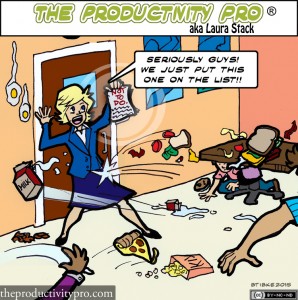 Sometimes, the best thing you can do in productivity terms is NOT to do something. I’ve talked for years about having not-to-do lists, which can prove as important as your to-do lists. A Not-To-Do list is precisely what it sounds like: a list of items you refuse to do—because they either waste your time, or the drawbacks outweigh the benefits.
Sometimes, the best thing you can do in productivity terms is NOT to do something. I’ve talked for years about having not-to-do lists, which can prove as important as your to-do lists. A Not-To-Do list is precisely what it sounds like: a list of items you refuse to do—because they either waste your time, or the drawbacks outweigh the benefits.
You probably have a Not-To-Do list, even if you don’t bother to write it down. For example, you might have long since decided not to take a certain route to work, because you arrive late when you do. Maybe you’ve decided never to accept phone calls or email from people you don’t already know, or to avoid personal communications at work. You may have decided to never eat at your desk, so you can get a little bit of refreshment before heading back to work.
Those represent minor examples; more profound ones include refusing work you don’t have time for, returning tasks to the people to whom they truly belong, or refusing to engage in office politics.
A Not-To-Do list applies to team productivity as well, though the team version typically includes extra items that need not appear on a personal list. Most teams have never even considered the concept or don’t want to invest the time. However, a simple lack of clarity can result in terrible productivity failures. Spend the time necessary to meet and work out your Not-To-Do list, because it’s more than worth the time and effort.
So what do you include? Anything you think slows you down as a team. A decision not to meet unless necessary would be a good start. Another might be to refuse to work at cross-purposes. That doesn’t mean you can’t disagree, even strongly—just that once you’ve collectively made a decision, everyone gets on board. Other list additions might include not to gossip, to avoid company politics, and never to make decisions unilaterally except in the case of the team lead. If you decide unilaterally to start publishing a certain report on Wednesday, because that makes the most sense to you, you may damage the workflow process of someone who needs it on Tuesdays.
Other items you may consider:
- No negativity.
- No griping.
- No talking loudly outside others’ offices.
- No undermining authority or teammates.
- No goldbricking (doing less work on purpose than you could).
- No data or resource hoarding.
- No bickering with other teams.
- No taking conference calls on your speaker phone.
What you decide to include on the Not-To-Do list is up to you and your teammates, as long as the majority agree it damages productivity. Just get together, talk it out, and make sure you’re all on the same page—so you can achieve maximum results as a team in the minimum time possible.
© 2015 Laura Stack. Laura Stack, a.k.a. The Productivity Pro®, helps professionals achieve Maximum Results in Minimum Time®. For over 20 years, her keynote speeches and workshops have helped leaders boost personal and team productivity, increase results, and save time at work. Laura is the author six books, most recently Execution IS the Strategy. Widely regarded as one of the leading experts in the field of performance and workplace issues, Laura has been featured in the Wall Street Journal, the New York Times, and USA Today. Connect via her website, Facebook, or Twitter.


